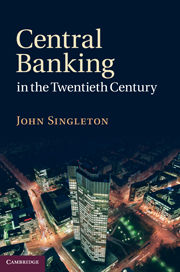Book contents
- Frontmatter
- Contents
- List of illustrations
- Acknowledgements
- List of abbreviations
- 1 A beginner's guide to central banking
- 2 Very boring guys?
- 3 Wind in the willows: the small world of central banking c. 1900
- 4 Something for everyone: new central banks, 1900–1939
- 5 A series of disasters: central banking, 1914–1939
- 6 The mysteries of central bank cooperation
- 7 The first central banking revolution
- 8 No time for cosmic thinkers: Central banking in the ‘Keynesian’ era
- 9 Rekindling central bank cooperation in the Bretton Woods era
- 10 The goose that lays the golden egg: Central banking in developing countries
- 11 The horse of inflation
- 12 The second central banking revolution: Independence and accountability
- 13 Reputations at stake: financial deregulation and instability
- 14 Inflation targeting: the holy grail?
- 15 The long march to European monetary integration
- 16 A world with half a million central bankers
- References
- Index
7 - The first central banking revolution
Published online by Cambridge University Press: 04 February 2011
- Frontmatter
- Contents
- List of illustrations
- Acknowledgements
- List of abbreviations
- 1 A beginner's guide to central banking
- 2 Very boring guys?
- 3 Wind in the willows: the small world of central banking c. 1900
- 4 Something for everyone: new central banks, 1900–1939
- 5 A series of disasters: central banking, 1914–1939
- 6 The mysteries of central bank cooperation
- 7 The first central banking revolution
- 8 No time for cosmic thinkers: Central banking in the ‘Keynesian’ era
- 9 Rekindling central bank cooperation in the Bretton Woods era
- 10 The goose that lays the golden egg: Central banking in developing countries
- 11 The horse of inflation
- 12 The second central banking revolution: Independence and accountability
- 13 Reputations at stake: financial deregulation and instability
- 14 Inflation targeting: the holy grail?
- 15 The long march to European monetary integration
- 16 A world with half a million central bankers
- References
- Index
Summary
[T]he Federal Reserve system is so unimportant, nobody believes anything that Marriner Eccles says or pays any attention to him.
President Franklin D. Roosevelt, December 1940 (quoted in Meltzer 2003: 556, n. 286)After all, it is not the theoretical constitution of the Institution that matters, but the spirit in which the partnership between the Ministry of Finance and the [Reserve] Bank is worked. The success of the partnership will, in the ultimate analysis, depend on the manner in which Government desires to be served and provides opportunities accordingly.
Chintaman Deshmukh, Governor of the Reserve Bank of India, 1948 (quoted in Jadhav 2003: 18)The world of central banking was transformed by a spate of nationalisations beginning in 1936, and by the assertion of more governmental influence over monetary and banking policy during and after the Second World War. Central banks became less autonomous in the middle of the twentieth century. The period from the mid 1930s to the late 1940s may be termed the first revolution in central banking, and its beginnings were discussed in the previous chapter. New institutional arrangements were imposed after the depression, and in some cases new leaders – most notably Eccles himself – were appointed. Though it might be tempting to see the 1930s and 1940s as an era in which central banks were conquered and occupied by governments, the new ethos was in fact one of partnership.
- Type
- Chapter
- Information
- Central Banking in the Twentieth Century , pp. 110 - 127Publisher: Cambridge University PressPrint publication year: 2010

